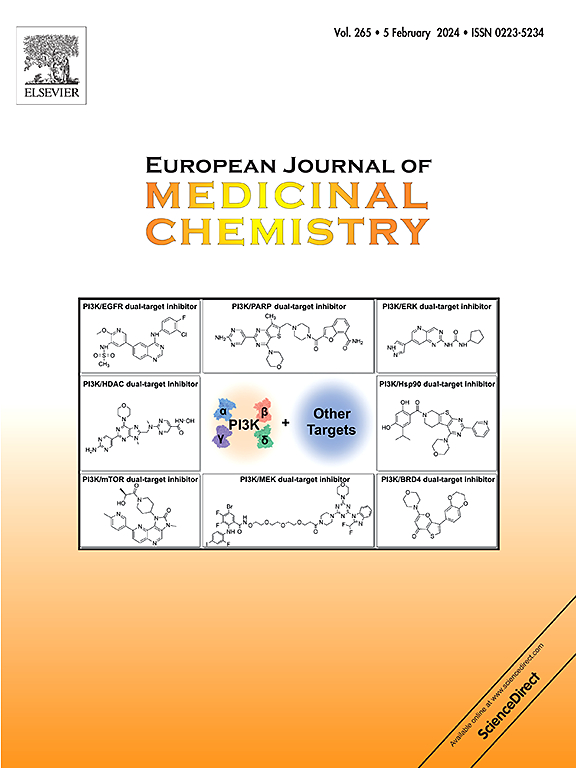吡咯[2,3-d]嘧啶衍生物作为新型FLT3/IRAK4抑制剂的发现
IF 6
2区 医学
Q1 CHEMISTRY, MEDICINAL
引用次数: 0
摘要
从先导化合物L-1开始,经过三轮合理的结构优化,开发出一系列吡咯[2,3-d]嘧啶衍生物作为FLT3/IRAK4抑制剂。其中HB-29对FLT3-WT (IC50 = 1.95 nM)和IRAK4 (IC50 = 53.72 nM)的活性显著高于阳性对照CA-4948。此外,它在具有不同FLT3-TKD和FLT3-ITD-TKD突变的MV4-11、MOLM3和BaF3细胞中表现出优异的活性,突出了其克服获得性耐药的潜力。HB-29对正常骨髓细胞系HS-5的毒性较低(SI >;2000)。机制研究显示HB-29以剂量依赖的方式抑制FLT3和IRAK4通路,促进细胞凋亡。值得注意的是,在细胞因子诱导的细胞模型中,HB-29有效地诱导细胞凋亡,同时还能增强SOD活性,减少ROS积累,从而显示出其克服适应性抗性的潜力。此外,HB-29表现出可接受的生物利用度(F = 13.4%)。这些发现证实FLT3/IRAK4抑制剂是一种治疗AML的有希望的策略。本文章由计算机程序翻译,如有差异,请以英文原文为准。
![Discovery of pyrrolo[2,3-d]pyrimidine derivatives as novel FLT3/IRAK4 inhibitors](https://img.booksci.cn/booksciimg/2025-6/2025061410385975148636.png)
Discovery of pyrrolo[2,3-d]pyrimidine derivatives as novel FLT3/IRAK4 inhibitors
Starting with the lead compound L-1, a series of pyrrolo[2,3-d]pyrimidine derivatives were developed as FLT3/IRAK4 inhibitors through three rounds of rational structural optimization. Among them, HB-29 had the remarkable activity towards FLT3-WT (IC50 = 1.95 nM) and IRAK4 (IC50 = 53.72 nM), outperforming the positive control, CA-4948. Besides, it exhibited excellent activities in MV4-11, MOLM3, and BaF3 cells with varying FLT3-TKD and FLT3-ITD-TKD mutations, highlighting its potential to overcome acquired resistance. The toxicity of HB-29 to normal bone marrow cell line HS-5 is relatively low (SI > 2000). Mechanistic studies revealed that HB-29 inhibited FLT3 and IRAK4 pathways in a dose-dependent manner, promoting cell apoptosis. Notably, in the cytokine-induced cell model, HB-29 efficiently induced apoptosis, and while also enhancing SOD activity and reducing ROS accumulation, thereby demonstrating its potential to overcome adaptive resistance. Moreover, HB-29 demonstrated an acceptable bioavailability (F = 13.4 %). These findings confirm that FLT3/IRAK4 inhibitor is a promising strategy for the treatment of AML.
求助全文
通过发布文献求助,成功后即可免费获取论文全文。
去求助
来源期刊
CiteScore
11.70
自引率
9.00%
发文量
863
审稿时长
29 days
期刊介绍:
The European Journal of Medicinal Chemistry is a global journal that publishes studies on all aspects of medicinal chemistry. It provides a medium for publication of original papers and also welcomes critical review papers.
A typical paper would report on the organic synthesis, characterization and pharmacological evaluation of compounds. Other topics of interest are drug design, QSAR, molecular modeling, drug-receptor interactions, molecular aspects of drug metabolism, prodrug synthesis and drug targeting. The journal expects manuscripts to present the rational for a study, provide insight into the design of compounds or understanding of mechanism, or clarify the targets.

 求助内容:
求助内容: 应助结果提醒方式:
应助结果提醒方式:


